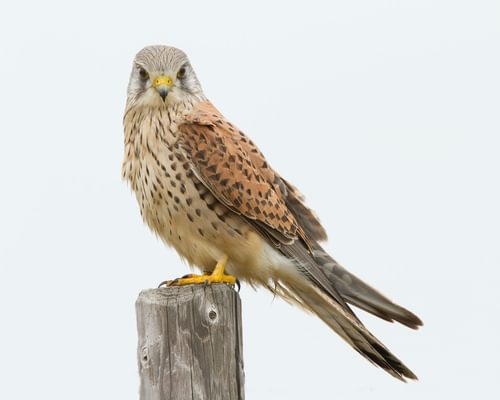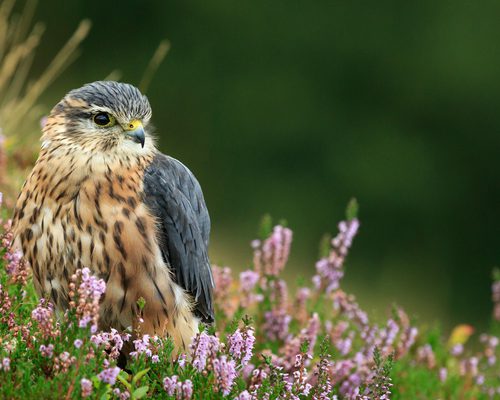Hobby
Falco subbuteo
Visual Identification
Appearance
The Hobby is a small, sleek falcon with long, pointed wings and a relatively short tail. Its upperparts are slate-grey, contrasting with a white throat and dark 'moustache' streaks. The underparts are white with bold black streaks. Eyes are brown with a yellow eye ring and white eyebrow, and legs are yellow.
Both sexes look similar, with females being slightly larger. Juveniles show a buffy wash on the underparts and less distinct streaking. In flight, the Hobby's silhouette resembles a large swift, with its streamlined body and sickle-shaped wings.
A useful identification feature is the reddish brown-coloured thighs and undertail coverts (the feathers that overlap the belly and tail), easily visible in flight or when the bird is perching on a branch or pole.
Size
Length
28cm to 35cm
Wingspan
70cm to 84cm
Weight
130g to 340g
Colours
Males and females have similar plumage
Primary Colour
Blue Grey
Secondary Colour
White Rufous
Beak Colour
Black
Leg Colour
Yellow
Habitat and Distribution
Habitats
Woodland
Garden
Wetland
Coastal
Urban
Farmland
Grassland
Desert
Tundra
Rainforest
Mountain
Savanna
Distribution
Hobbies inhabit open woodlands, forest edges, and farmland with scattered trees across Europe and Asia. They prefer areas near water bodies, which attract their insect prey. During summer, they breed across much of Europe, including the UK.
In winter, Hobbies migrate to sub-Saharan Africa and southern Asia. They are absent from most of their European range from September to April, returning to breed in late spring.
In the UK, the hobby can be found across England, most of Wales and more recently in small numbers in southern Scotland, generally appearing between April and October.
Elevation Range
Up to 2,000 meters
Climate zones
Temperate, Subtropical
Distribution Map
This map gives you a rough idea of where you might spot a Hobby. The coloured areas show countries where these birds have been seen.
A few things to keep in mind:
- Birds might not be everywhere in the coloured areas, for example, they may be present around the coast of that country
- Where birds live can change with seasons and available food
- This map is quite simple - it doesn't show exact locations
We're working on making our maps even better! Soon, we hope to show you:
- More detailed maps for bigger countries, including state and region
- How birds move around during different seasons
Distribution by Region
Behaviour and Ecology
Bird Attributes
This feature is in beta. We'd love your feedback to improve it!
Share your thoughtsBird Attributes Explained
Our bird attributes system rates various aspects of a bird's capabilities on a scale of 0-100, based on data from field observations, scientific studies, and expert knowledge.
Attribute Categories:
- Agility: Manoeuvrability, speed, and grace in flight or movement.
- Strength: Physical power, often correlating with size and hunting abilities.
- Adaptability: Ability to thrive in various environments or changing conditions.
- Aggressiveness: Territorial behaviour and assertiveness, particularly during breeding seasons.
- Endurance: Stamina, often seen in migration patterns or foraging behaviours.
Understanding the Ratings:
- 0-20: Very Low
- 21-40: Low
- 41-60: Average
- 61-80: High
- 81-100: Very High
Remember, these attributes are relative to other bird species and don't necessarily indicate superiority.
Hover over the icon next to each attribute for more information.
Tap the icon next to each attribute for more information.
Agility
Reflects the bird's manoeuvrability, speed, and grace in flight or movement.
The Hobby is renowned for its exceptional aerial agility, capable of outmanoeuvring swifts and catching insects mid-flight. Its streamlined body and sickle-shaped wings contribute to its remarkable manoeuvrability.
Strength
Indicates the bird's physical power, often correlating with size and hunting abilities.
While not exceptionally strong for its size, the Hobby possesses sufficient strength to capture small birds in flight and carry insects. Its ability to hunt swifts demonstrates a respectable level of power.
Adaptability
Represents the bird's ability to thrive in various environments or changing conditions.
Hobbies show good adaptability, inhabiting various environments from woodlands to farmlands and urban areas. Their ability to adjust their diet seasonally and utilise existing nests also indicates strong adaptive capabilities.
Aggressiveness
Measures the bird's territorial behaviour and assertiveness, particularly during breeding seasons.
Hobbies display moderate aggression, particularly during hunting and territorial disputes. Their bold hunting strategy of pursuing swift-flying prey and their willingness to chase off intruders suggest a notable level of assertiveness.
Endurance
Reflects the bird's stamina, often seen in migration patterns or foraging behaviours.
The Hobby's long-distance migration between Europe and sub-Saharan Africa, coupled with its ability to engage in extended aerial hunts, indicates impressive endurance. Its capacity for sustained flight during migration and hunting demonstrates remarkable stamina.
Diet
Behaviour
Hobbies are known for their incredible aerial agility. They are often seen chasing insects and small birds in mid-air. They frequently hunt in pairs, with one bird flushing prey while the other pursues.
During courtship, males perform spectacular sky-dancing displays, showcasing their speed and manoeuvrability.
Vocalisation
Although generally a silent bird, the Hobby's call is a rapid, high-pitched 'kew-kew-kew' or 'kee-kee-kee', often given during territorial disputes or when alarmed. During courtship, males produce a softer, chattering call. Their vocalisations are less frequent and less varied than many other falcon species.
Nesting & Breeding
Hobbies typically form monogamous pairs and begin breeding in May or June. They do not build their own nests; instead, they take over the old nests of other birds, particularly crows.
The female lays 2-3 eggs, which are creamy-white with reddish-brown spots. Both parents share incubation duties, which lasts about 28-31 days.
Chicks fledge after 28-34 days but remain dependent on their parents for several weeks, perfecting their flying and hunting skills.
Conservation and Status
Global Conservation Status
While the Hobby is currently listed as Least Concern, it faces threats from habitat loss and agricultural intensification. Climate change may affect its prey availability and migration patterns. Conservation efforts focus on protecting breeding habitats and maintaining insect-rich environments.
Birdwatching Tips
- Look for Hobbies near woodland edges or open areas with scattered trees
- Observe their swift, agile flight, often mistaken for that of a large swift
- Its wingbeats are smooth and relaxed, although it can accelerate or dive in an instant
- Listen for their high-pitched 'kew-kew-kew' calls during the breeding season
- In the UK, watch for them hunting dragonflies over lakes and reservoirs in late summer
- The bright white cheek patternation and red-brown undertail colouration provide an easy reference for the positive identification of this bird
Additional Information
Quick Facts
Predators
Adult Hobbies have few natural predators due to their agility, but eggs and nestlings may fall prey to martens, crows, and larger birds of prey.
Did You Know?
- Hobbies can catch and eat their insect prey in mid-air without landing.
- They are among the few birds that can outfly and catch swifts.
- The name 'Hobby' comes from the French 'hobet', meaning a small bird of prey.
- Some years ago, a satellite tracking experiment with a hobby found that it took the bird just four days to cross the Sahara Desert, and on another occasion, a similar bird was recorded as travelling some 1,250 kilometres in just two days.
Similar Birds
References
- 1 2
website: BirdLife International. 2021. Falco subbuteo. The IUCN Red List of Threatened Species 2021: e.T22696460A206270514.
View source - 3
report, 1994: del Hoyo et al.
Share Your Feedback
We value your opinion! Let us know what you think about this bird page.

